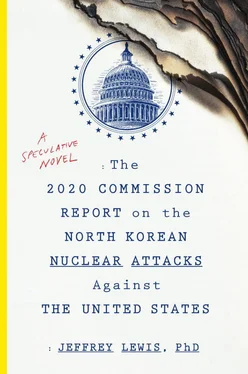The Olympic Security Command Center (OSCC) was now largely functional and outside of central Tokyo: Tokyo’s Olympic Security Command Center is described in Eva Kassens-Noor and Tatsuya Fukushige, “Tokyo 2020 and Beyond: The Urban Technology Metropolis,” Journal of Urban Technology, published online July 1, 2016, https://doi.org/10.1080/10630732.2016.1157949.
Oh Soo-hyun shared a name with a doctor in a Korean soap opera: There really is a South Korean television drama with a doctor named Oh Soo Hyun. The Dr. Oh depicted here, however, is a fictional homage to the real Dr. Terafumi Sasaki, who was profiled in John Hersey’s Hiroshima (New York: Alfred A. Knopf, 1946).
With more than 72,000 hospital beds: The statistics in this section are drawn from Oh Youngho, “Optimal Supply and the Efficient Use of Hospital Bed Resources in Korea,” Working Paper 2015-21, Korea Institute of Health and Social Affairs, 2015.
After reassessing the status of North Korea’s nuclear development: The 2017 reassessment of the size of North Korea’s nuclear arsenal is detailed in two news reports from August of that year. “The analysis, completed last month by the Defense Intelligence Agency, comes on the heels of another intelligence assessment that sharply raises the official estimate for the total number of bombs in the communist country’s atomic arsenal. The United States calculated last month that up to 60 nuclear weapons are now controlled by North Korean leader Kim Jong Un.” Joby Warrick, Ellen Nakashima, and Anna Fifield, “North Korea Now Making Missile-Ready Nuclear Weapons, US Analysts Say,” Washington Post, August 8, 2017.
The low end remained at thirty: “Some US assessments conclude North Korea has produced or can make around 30 to 60 nuclear weapons, said two US officials who weren’t authorized to discuss sensitive intelligence matters and demanded anonymity.” “Estimates of North Korea’s Nuclear Weapons Are Difficult to Nail Down,” Associated Press, August 18, 2017.
North Korea could be adding as many as twelve nuclear weapons a year to its arsenal: “Sources have told The Diplomat that the DIA assesses North Korea, given its current uranium enrichment activities, is likely capable of generating an additional 12 weapons worth of fissile material a year. The DIA assessment of 60 weapons assumes the use of composite pit core designs for nuclear bombs by North Korea; composite pits combine plutonium-239 and uranium highly enriched in uranium-235, the two fissile material isotopes suitable for nuclear bombs, to more efficiently design bombs.” Ankit Panda, “US Intelligence: North Korea May Already Be Annually Accruing Enough Fissile Material for 12 Nuclear Weapons,” Diplomat, August 9, 2017.
The estimate that increased the number of North Korean nuclear weapons… had even been leaked to the Washington Post in the summer of 2017: Warrick, Nakashima, and Fifield, “North Korea Now Making Missile-Ready Nuclear Weapons.”
“It was built of four and a half feet of steel and concrete”: Donald Trump, as quoted in Tom Junod, “Trump,” Esquire, January 29, 2007.
“Kim’s missiles keep crashing”: Jeremy Scahill, Alex Emmons, and Ryan Grim, “Read the Full Transcript of Trump’s Call with Philippine President Rodrigo Duterte,” Intercept, May 23, 2017.
Mike Pompeo… had figured out… how to carefully move the goalposts by referring to North Korea’s ability to build a reliable ICBM: See, for example, Pompeo’s remarks at the Foundation for the Defense of Democracies 2017 National Security Summit, held on October 19, 2017.
“We have missiles that can knock out a missile in the air 97 percent of the time”: Glenn Kessler, “Trump’s Claim That a US Interceptor Can Knock out ICBMs ‘97 Percent of the Time,’” Washington Post, October 13, 2017.
The current plan, OPLAN 5015, was a preemptive attack: Park Byong-su, “S. Korean and US Militaries Draw up a New Operation Plan,” Hankyoreh, August 28, 2015.
“The nuclear weapon’s only good against cities”: Interview with General Charles Horner, commander of the US Ninth Air Force, conducted by Frontline / BBC, c. 1995.
“No one advanced the notion of using nuclear weapons”: George H. W. Bush and Brent Scowcroft, A World Transformed: The Collapse of the Soviet Empire, the Unification of Germany, Tiananmen Square, the Gulf War (New York: Alfred A. Knopf, 1998), 463.
When Mattis was out of government, he worked closely at Stanford with George Shultz: Paul Sonne, “How Mattis Changed His Mind on Nuclear Weapons,” Washington Post, February 5, 2018.
“I don’t think there’s any such thing as a tactical nuclear weapon”: Aaron Mehta, “Mattis: No Such Thing as a ‘Tactical’ Nuclear Weapon, but New Cruise Missile Needed,” Defense News, February 6, 2018.
8. A World without North Korea
Kim Jong Un… knocked it down: Curtis Melvin, “Kim Il Sung’s Hyangsan Palace Demolished: Building Kim Il Sung Reported to Have Died in Razed, Replaced with Young Trees,” NK News, April 24, 2014.
In 2019, Kim ordered the construction of a magnificent new palace: The construction of the palace is a fiction, but the construction of the airstrip is real. James Pearson, “The Flying Marshal: North Korea Builds Private Runways for Plane-Loving Kim,” Reuters, August 19, 2015.
Admiral Philip Davidson was the commander of US Pacific Command: The depiction of Davidson is based on Gordon Lubold and Nancy A. Youssef, “Likely US Pacific Commander Has Spent Little Time in Asia,” Wall Street Journal, March 2, 2018.
popular with the press and fawning politicians for his blunt remarks: Jane Perlez, “A US Admiral’s Bluntness Rattles China, and Washington,” New York Times, May 6, 2016.
The Chinese government in particular reportedly had sought Harris’s removal: “China Urged US to Fire Pacific Command Chief Harris in Return for Pressure on North Korea,” Kyodo, May 6, 2017.
Although some found Harris undiplomatic, Trump did not: Gerry Mullany and Jacqueline Williams, “Trump’s Pick for US Ambassador to Australia Heads to Seoul Instead,” New York Times, April 24, 2018.
In one case, the phrase caused a minor panic: Dan Lamothe, “‘Fight Tonight’? Explaining Trump’s Retweet That Says US Bombers Are Ready to Strike North Korea,” Washington Post, August 11, 2017.
It turned out that Iraqi units, facing heavy bombardment, had simply deserted their equipment: Perry D. Jamieson, Lucrative Targets: The US Air Force in the Kuwaiti Theater of Operations (Washington, DC: US Air Force, Air Force History and Museums Program, 2001), 90–91.
“reduce the US mainland into ashes and darkness”: “KAPPC Spokesman on DPRK Stand toward UNSC ‘Sanctions Resolution,’” KCNA, September 13, 2017.
The phrase came up again and again in interrogations: The quotation and a story about its meaning told by a North Korean defector named Kim Hyun Sik appear in “The Secret History of Kim Jong Il,” Foreign Policy, October 6, 2009.
the United States could not confirm that even a single one of Sad-dam’s Scuds had been destroyed: According to an official postwar assessment, “there is no indisputable proof that Scud mobile launchers—as opposed to high-fidelity decoys, trucks, or other objects with Scud-like signatures—were destroyed by fixed-wing aircraft.” Thomas A. Kearney and Eliot A. Cohen, Gulf War Air Power Survey: Summary Report (Washington, DC: US Government Printing Office, 1993), 89–90.
Читать дальше












